The World Café
|
Field of application |
Guided larger group conversations and reflections
|
|
Resume / Brief description
|
Making the informal formal and collecting joint knowledge of the participants is the objective of a World Café. Its logic is to encourage a reflection along 3 question rounds. The first round starts with a rather generic question and then is followed by more concrete ones that are oriented to find concrete common results.
The methodology is used for group reflections that want to integrate all participants. It is a very interactive format in which participants exchange on the questions based on their knowledge. It assures that everybody gets a voice and that communication is assured in an egalitarian way. It takes out of the conversation hierarchies (e.g. between students and teachers, between R&D organisations and the community, between teachers) and focuses on the connection of ideas and suggestions.
The World Café can be used
|
|
Target group
|
|
| Group size
|
Minimum 12 - up to 300 people and more |
|
Objectives |
The World Café aims to
|
|
Requirements
|
In case of online realisation, the requirements need to be adapted. Working e. g. with Zoom break-out sessions and mural board documentation provide a good alternative.
|
| Time
|
20 minutes for each question round, minimum 1 hour plus the introduction and explanation of the purpose of the World Café, its methodology, rules and roles, and feedback of findings (altogether minimum 1.5 hours) |
|
Implementation -Overview |
The methodology is realised in three main organisational steps.
|
|
Implementation - Guidelines
|
The preparation has to be adjusted to the target group and the context in which it is applied. When working as university staff with external actors, official invitations and procedures should be applied. For internal reflection e.g. with university and department staff, the format can be applied in a joint meeting. In a student class it also can be applied as a didactical instrument. In all 3 application formats there is a sequence of preparation to be considered:
1. Preparation
1.1. Clarification of the purpose
The World Café can be used for e.g.
1.2. Phrasing of the questions
Phrasing suitable questions is key to reach the purpose of the World Café. The logic of phrasing follows a funnel logic. It starts with a rather generic question to get the communication going, then a more concrete question related to the purpose of the meeting, then a final question that provides the opportunity to get a concrete outcome.
1.3. Preparation of the event
This includes invitation but also setting up the space:
2. Realisation of the World Café
2.1. Welcome speech and introduction to the purpose and sequence
One of the key questions that can be asked to the audience is: “Where do you have most informal exchange on an official event” The answer in general is: “During the coffee breaks.” The World Café has the logic to encourage informal communication and exchange in a formal structure. It is relevant to give a short overview of the structure of the World Café (3 questions, groups are mixing, and tables are changed after each question, each reflection on a question is e.g. 20 minutes). The explanation of rules and roles are relevant finally (in the first-round group at each table chooses one host who stays at each table through all question rounds, everybody takes the markers and doodles and draws on the table cloth, every comment is documented or visualized on the table cloth etc.). Then the group is asked to find themselves up at different tables before the first round of question starts.
2.2. First round of questions
The first round of questions is beginning, and answers are getting documented in one colour (e.g. green). Answers to the questions get exchanged and documented on the table cloth (using symbols and graphics, not only words is encouraged). At the end of the 1st question round each participant is asked to look for a new table with a new group of participants (e.g. students). Only the selected host stays at the same table to brief the newcomers.
2.3. Second round of questions
Before the second question is presented, the host presents the main answers from the first round of reflection (only 2 minutes to wrap up). Meanwhile, moderators take the green markers from the table and exchange it with a new colour (e.g. red). Then the second question is presented to the participants. The reflections on answers related to the second question get then documented by the participants in a different colour (e.g. red). At the end of the second question round each participant is asked to look for a new table with a new group of participants. Only the selected host stays at the same table to brief again the newcomers.
2.4. Third round of questions
Before the third question is presented, the host presents the main answers from the second round of reflection (only 2 minutes to wrap up). Meanwhile, moderators take the red markers from the table and exchange it with a new colour (e.g. blue). Then the third and last question is presented to the participants. The reflections on answers related to the third question get then documented by the participants in a different colour (e.g. blue).
3. Reflection of findings
3.1. Summarising main findings
The hosts at each table are asked to give a synthesis of the main answers on each question at their table. The results are documented in a mind map (on a pin board or flipchart).
3.2. Reflection on main steps forward
It is important to reflect on how to make use of the information collected or how to move forward as a next step. The momentum that is created provides the opportunity to become well documented and to make use of (e.g. through the realisation of the ideas or further planning steps).
|
|
Example of application |
Local Economic Development Forum in a city (and in a Student) for a reflection on Local Economic Development
The following examples come from a Summer Academy on Economic Development in Germany for experts and practitioners and from a student course at the SEPT Master Course in Germany. In both events the main topic to reflect on is local economic development (LED). The logic of the World Café was oriented to 1) Identify common knowledge on what LED is all about 2) Reflect about key challenges in LED in a respective city/place 3) Identify key success criteria for LED
Designing a pin board with main objectives of the World Café and application of examples (if existing)
Students and local practitioners were provided examples of the use of the World Café in different projects and local events in the world. Along this board also the objectives of the world café logic were explained. Stressing out the logic of making the informal talk formal is a key aspect of the World Café as well as making use of common knowledge and getting to know each other through discussing and reflecting on concrete targeted questions.
Description of the rules and roles of the World Café sequence In the local city workshop/training the description of the main rules and roles were provided. This can be done on a pin board, flipchart or on a PowerPoint. Presenting it in a nice visualised way encourages the participants to also visualise on the table cloths and to make use of symbols while jointly reflecting.
Presentation of one question after the other in the sequence
In a local economic development event with stakeholders a pin board to demonstrate the questions was used while in a student class a PowerPoint was used to present the three question in a sequence.
Summarising the discussions from the different round tables A mind map is a good way to document the main findings of the discussions. The hosts are asked to come up with their main important findings which are then documented directly on the mind map. It provides a good joint reflection of the large group.
Documentation of the results The summary reflection provides a good overview of the overall discussion. But each tablecloth table also entails many additional information. In a conference, these additional findings can be documented in a written format or photographed as documentation.
The events with the World Café are organised by very different stakeholders in very different communities. In large public events, the core group who organises the World Café should make sure to have a number of moderators with them who visit the different tables and who make sure that people are not only talking but also documenting their reflections on the tablecloths.
|
|
Templates, Graphics for download
|
|
|
Additional format/references
|
|

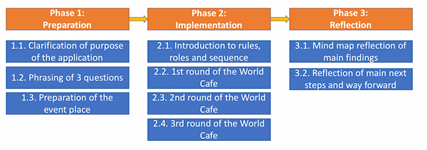
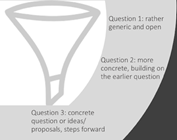
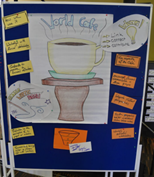
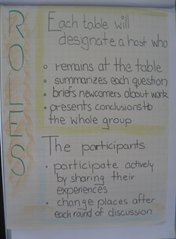
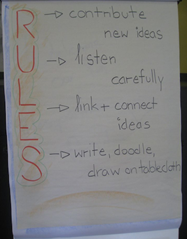
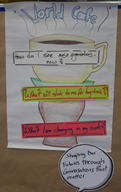
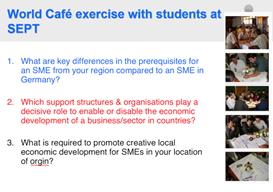
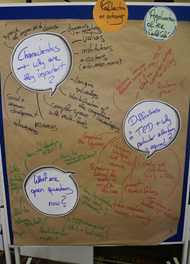
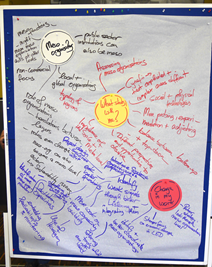
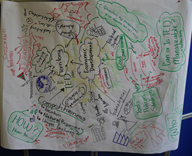
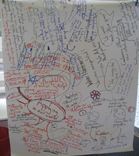
No Comments